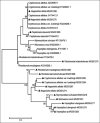Opportunistic pathogenic fungi isolated from feces of feral pigeons in Mafikeng, North West Province of South Africa
- PMID: 31528034
- PMCID: PMC6702576
- DOI: 10.14202/vetworld.2019.1066-1069
Opportunistic pathogenic fungi isolated from feces of feral pigeons in Mafikeng, North West Province of South Africa
Abstract
Background and aim: Pigeon feces are increasingly being implicated in the spread of bacterial pathogens such as Escherichia coli, Campylobacter, Salmonella, Listeria, and Chlamydia. Fungi are rarely investigated except for Cryptococcus that has emerged as an important pathogen in old people and immunosuppressed patients. This study investigated fungi in pigeon feces collected from Mafikeng, the North West Province of South Africa.
Materials and methods: Freshly dropped feces were collected and enriched in phosphate-buffered saline overnight at 48°C and then subcultured on Sabouraud's dextrose agar and incubated at 48°C for 2 weeks observing any fungal growth from day 2. The growths were picked up, DNA extracted, and polymerase chain reaction was done using the internal transcribed spacer primers.
Results: Fungi isolated included: Aspergillus (Aspergillus tubingensis), Cryptococcus (Cryptococcus albidus and Cryptococcus randhawai), Fusarium spp., and Rhodotorula (Rhodotorula mucilaginosa and Rhodotorula kratochvilovae). Most of these isolates are known opportunistic pathogens and have been isolated in clinical conditions elsewhere. Other isolates such as Graphium dubautiae, Myrmecridium schulzeri, Naganishia albida, Paecilomyces lilacinus, and Zygopleurage zygospora were not found to be of any human health significance.
Conclusion: We, therefore, concluded that the presence of these opportunistic pathogens is a significant human health risk, especially in the face of the HIV/AIDS pandemic that results in immunosuppression.
Keywords: chain reaction; fungi; opportunistic pathogens; pigeon feces; polymerase.
Figures


References
-
- Chae H, Park G, Kim S, Jo H, Kim J, Jeoung H, An D, Kim N, Shin B, Kang Y. Rapid direct identification of Cryptococcus neoformans from pigeon droppings by nested PCR using CNLAC1 gene. Poult. Sci. 2012;91(8):1983–1989. - PubMed
-
- Tanaka C, Miyazawa T, Watarai M, Ishiguro N. Bacteriological survey of feces from feral pigeons in Japan. J. Vet. Med. Sci. 2005;67(9):951–953. - PubMed
-
- Shah S, Birnbaum B, Jacobs J. Disseminated aspergillosis inciting intestinal ischemia and obstruction. Br. J. Radiol. 2001;74(888):1145–1147. - PubMed
-
- Dannaoui E, Garcia-Hermoso D. New Insights in Medical Mycology. New York: Springer; 2007. The Zygomycetes; pp. 159–183.
LinkOut - more resources
Full Text Sources
Miscellaneous
